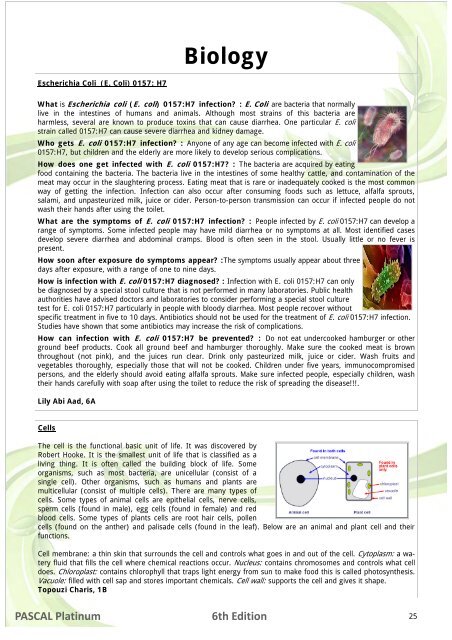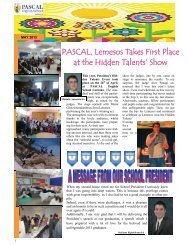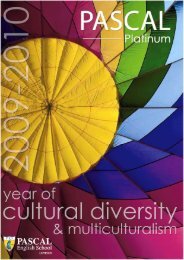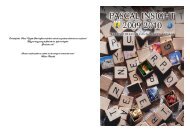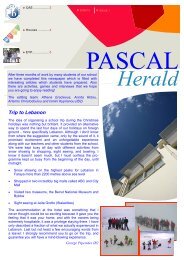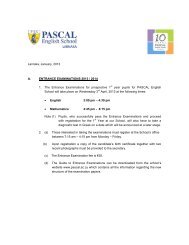PASCAL Platinum 6th Edition
PASCAL Platinum 2010/11 - Pascal Education
PASCAL Platinum 2010/11 - Pascal Education
- No tags were found...
You also want an ePaper? Increase the reach of your titles
YUMPU automatically turns print PDFs into web optimized ePapers that Google loves.
BiologyEscherichia Coli (E. Coli) 0157: H7What is Escherichia coli (E. coli) 0157:H7 infection? : E. Coli are bacteria that normallylive in the intestines of humans and animals. Although most strains of this bacteria areharmless, several are known to produce toxins that can cause diarrhea. One particular E. colistrain called 0157:H7 can cause severe diarrhea and kidney damage.Who gets E. coli 0157:H7 infection? : Anyone of any age can become infected with E. coli0157:H7, but children and the elderly are more likely to develop serious complications.How does one get infected with E. coli 0157:H7? : The bacteria are acquired by eatingfood containing the bacteria. The bacteria live in the intestines of some healthy cattle, and contamination of themeat may occur in the slaughtering process. Eating meat that is rare or inadequately cooked is the most commonway of getting the infection. Infection can also occur after consuming foods such as lettuce, alfalfa sprouts,salami, and unpasteurized milk, juice or cider. Person-to-person transmission can occur if infected people do notwash their hands after using the toilet.What are the symptoms of E. coli 0157:H7 infection? : People infected by E. coli 0157:H7 can develop arange of symptoms. Some infected people may have mild diarrhea or no symptoms at all. Most identified casesdevelop severe diarrhea and abdominal cramps. Blood is often seen in the stool. Usually little or no fever ispresent.How soon after exposure do symptoms appear? :The symptoms usually appear about threedays after exposure, with a range of one to nine days.How is infection with E. coli 0157:H7 diagnosed? : Infection with E. coli 0157:H7 can onlybe diagnosed by a special stool culture that is not performed in many laboratories. Public healthauthorities have advised doctors and laboratories to consider performing a special stool culturetest for E. coli 0157:H7 particularly in people with bloody diarrhea. Most people recover withoutspecific treatment in five to 10 days. Antibiotics should not be used for the treatment of E. coli 0157:H7 infection.Studies have shown that some antibiotics may increase the risk of complications.How can infection with E. coli 0157:H7 be prevented? : Do not eat undercooked hamburger or otherground beef products. Cook all ground beef and hamburger thoroughly. Make sure the cooked meat is brownthroughout (not pink), and the juices run clear. Drink only pasteurized milk, juice or cider. Wash fruits andvegetables thoroughly, especially those that will not be cooked. Children under five years, immunocompromisedpersons, and the elderly should avoid eating alfalfa sprouts. Make sure infected people, especially children, washtheir hands carefully with soap after using the toilet to reduce the risk of spreading the disease!!!.Lily Abi Aad, 6ACellsThe cell is the functional basic unit of life. It was discovered byRobert Hooke. It is the smallest unit of life that is classified as aliving thing. It is often called the building block of life. Someorganisms, such as most bacteria, are unicellular (consist of asingle cell). Other organisms, such as humans and plants aremulticellular (consist of multiple cells). There are many types ofcells. Some types of animal cells are epithelial cells, nerve cells,sperm cells (found in male), egg cells (found in female) and redblood cells. Some types of plants cells are root hair cells, pollencells (found on the anther) and palisade cells (found in the leaf). Below are an animal and plant cell and theirfunctions.Cell membrane: a thin skin that surrounds the cell and controls what goes in and out of the cell. Cytoplasm: a wateryfluid that fills the cell where chemical reactions occur. Nucleus: contains chromosomes and controls what celldoes. Chloroplast: contains chlorophyll that traps light energy from sun to make food this is called photosynthesis.Vacuole: filled with cell sap and stores important chemicals. Cell wall: supports the cell and gives it shape.Topouzi Charis, 1B<strong>PASCAL</strong> <strong>Platinum</strong> <strong>6th</strong> <strong>Edition</strong> 25


